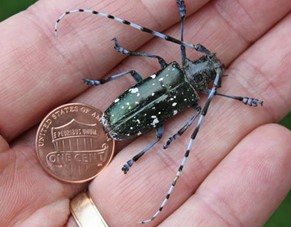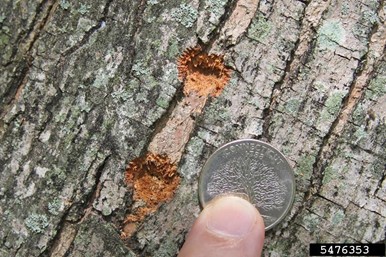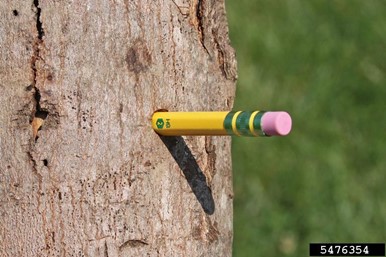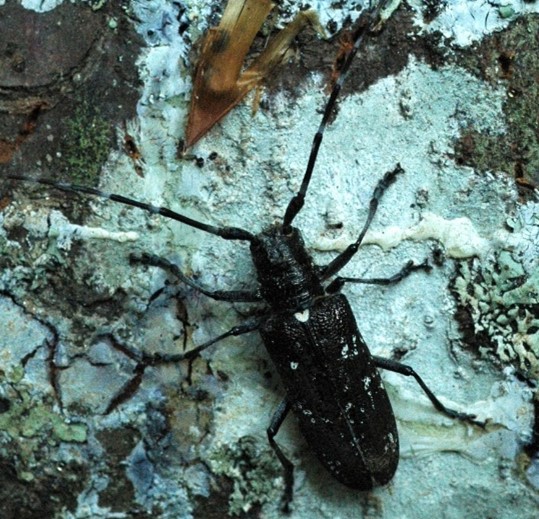Author: Ginger Nickerson, UVM Extension

Adult Asian Longhorned Beetle. Credit: Joe Boggs, Ohio State University, Bugwood.org
When you are in your sugarbush this winter, be on the lookout for signs of Asian longhorned beetle (ALB). ALB is a wood-boring insect, native to southeast Asia.
This highly destructive pest will kill many hardwood trees. However, its preferred host is the beloved maple. It has not yet been confirmed in Vermont. However, there is an active infestation in Worcester County, Massachusetts. The beetle threatens all species of maples. It is spread through moving infested firewood, nursery stock, or infested wood products.
While the summer and early fall are the best times to see the adult beetles, winter is an excellent time to examine your trees for signs of ALB damage. Take pictures of any signs you see and report suspicious trees to VTinvasives.org.
Signs to Look For:

Egg laying site. Credit: Joe Boggs, Ohio State University, Bugwood.org
Multiple round, shallow indentations in the bark with rough edges. These are dime-sized spots the beetles chew to lay their eggs. The spots may ooze sap in the summer and fall when they are fresh.
Perfectly round, pencil to dime-sized holes. These are left when the adults emerge in the summer. The exit hole will be straight and at least one inch deep. Stick a pencil in the hole to test if it is deeper than a tap hole. There may be bits of sawdust-like material around these holes, in branch crooks, or at the base of the tree.

Asian Longhorned Beetle exit hole. Credit: Joe Boggs, Ohio State University, Bugwood.org
Adult beetles are 3 / 4 inch - 1.5" long with antennae that are 1 to 2 times its body length. They are shiny black with white spots and antennae with bluish-black and white stripes. They look like the native whitespotted pine sawyer beetle. However, the whitespotted pine sawyer has a white spot between its wing covers.
In addition to attacking all maple species, ALB will also harm healthy ash, poplar, birch, willow, and elm. When ALB is found, all hardwood trees within a certain radius are destroyed to stop the pest from spreading. A quarantine is set up around the infested area to stop people from moving wood.
The infestation in Worcester, Massachusetts had probably been in the area for about ten years before it was found. Over 36,265 trees in a 110 square mile area in Worcester County have been removed trying to get rid of the beetle. In contrast, Chicago eradicated an ALB infestation and destroyed only 1,500 trees because the infestation was discovered early. Checking hardwoods, especially maples, for signs of ALB is key to early detection.

Look-alike: White Spotted Sawyer Beetle. Credit: William M. Ciesla, Forest Health Management International, Bugwood.org
Let’s keep Vermont’s maples ALB free!